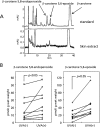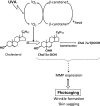Singlet molecular oxygen-quenching activity of carotenoids: relevance to protection of the skin from photoaging
- PMID: 21297913
- PMCID: PMC3022065
- DOI: 10.3164/jcbn.11-008FR
Singlet molecular oxygen-quenching activity of carotenoids: relevance to protection of the skin from photoaging
Abstract
Carotenoids are known to be potent quenchers of singlet molecular oxygen [O(2) ((1)Δ(g))]. Solar light-induced photooxidative stress causes skin photoaging by accelerating the generation of reactive oxygen species via photodynamic actions in which O(2) ((1)Δ(g)) can be generated by energy transfer from excited sensitizers. Thus, dietary carotenoids seem to participate in the prevention of photooxidative stress by accumulating as antioxidants in the skin. An in vivo study using hairless mice clarified that a O(2) ((1)Δ(g)) oxygenation-specific peroxidation product of cholesterol, cholesterol 5α-hydroperoxide, accumulates in skin lipids due to ultraviolet-A exposure. Matrix metalloproteinase-9, a metalloproteinase family enzyme responsible for the formation of wrinkles and sagging, was enhanced in the skin of ultraviolet-A -irradiated hairless mice. The activation of metalloproteinase-9 and the accumulation of 5α-hydroperoxide, as well as formation of wrinkles and sagging, were lowered in mice fed a β-carotene diet. These results strongly suggest that dietary β-carotene prevents the expression of metalloproteinase-9 (at least in part), by inhibiting the photodynamic action involving the formation of 5α-hydroperoxide in the skin. Intake of β-Carotene therefore appears to be helpful in slowing down ultraviolet-A -induced photoaging in human skin by acting as a O(2) ((1)Δ(g)) quencher.
Keywords: carotenoids; cholesterol hydroperoxide; matrix metalloproteinase; photoaging; singlet molecular oxygen.
Figures





References
-
- Krinsky NI. The antioxidant and biological properties of the carotenoids. Ann N Y Acad Sci. 1998;854:443–447. - PubMed
-
- Niki E, Yoshida Y, Saito Y, Noguchi N. Lipid peroxidation: mechanism, inhibition, and biological effects. Biochem Biophys Res Commun. 2005;338:668–676. - PubMed
-
- Burton GW, Ingold KU. β-Carotene: an unusual type of lipid antioxidant. Science. 1984;224:569–573. - PubMed
-
- Lim BP, Nagao A, Terao J, Tanaka K, Suzuki T, Takama K. Antioxidant activity of xanthophylls on peroxyl radical-mediated phospholipid peroxidation. Biochim Biphys Acta. 1992;1126:178–184. - PubMed
-
- Tsuchihashi H, Kigoshi M, Iwatsuki M, Niki E. Action of beta-carotene as an antioxidant against lipid peroxidation. Arch Biochem Biophys. 1995;323:137–147. - PubMed
LinkOut - more resources
Full Text Sources
Other Literature Sources

